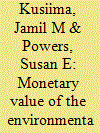|
|
|
Sort Order |
|
|
|
Items / Page
|
|
|
|
|
|
|
| Srl | Item |
| 1 |
ID:
115652


|
|
|
|
|
| Publication |
2012.
|
| Summary/Abstract |
Electricity production causes unintended impacts. Their exclusion by the market leads to suboptimal resource allocations. Monetizing and internalizing of external costs, though challenging and debatable, leads to a better allocation of economic resources and welfare. In this paper, a life-cycle analysis (LCA) on the production of electricity from conventional coal based electricity generation system has been performed in order to examine the environmental impacts of coal based electricity generating systems in the twin-city of Ahmedabad and Gandhinagar in western India. By using dose-response functions, we make an attempt to estimate the damages to human health, crops, and building materials resulting from the operation of coal power plants and its associated mines. Further, we use geographic information system to account for spatially dependent data. Finally, monetary values have been assigned to estimate the damage to human health, crops and building materials. This study reveals that the health as well as on non-health impacts of air pollution resulting from coal based electricity generation may not be ignored both in absolute as well as economic value terms.
|
|
|
|
|
|
|
|
|
|
|
|
|
|
|
|
| 2 |
ID:
150426


|
|
|
|
|
| Summary/Abstract |
Recently, the estimation of accident costs within the social costs of nuclear power plants (NPPs) has garnered substantial interest. In particular, the risk aversion behavior of the public toward an NPP accident is considered an important factor when integrating risk aversion into NPP accident cost. In this study, an integrated framework for the external cost assessment of NPP accident that measures the value of statistical life (VSL) and the relative risk aversion (RRA) coefficient for NPP accident based on an individual-level survey is proposed. To derive the willingness to pay and the RRA coefficient for NPP accident risks, a survey was conducted on a sample of 1550 individuals in Korea. The estimation obtained a mean VSL of USD 2.78 million and an RRA coefficient of 1.315. Based on the estimation results in which various cost factors were considered, a multiplication factor of 5.16 and an external cost of NPP accidents of 4.39E−03 USD-cents/kW h were estimated. This study is expected to provide insight to energy policy decision-makers on analyzing the economic validity of NPP compared to other energy sources by reflecting the estimated external cost of NPP accident into the unit electricity generation cost of NPP.
|
|
|
|
|
|
|
|
|
|
|
|
|
|
|
|
| 3 |
ID:
096099


|
|
|
|
|
| Publication |
2010.
|
| Summary/Abstract |
This research is aimed at monetizing the life cycle environmental and health externalities associated with production of ethanol from corn, corn stover, switchgrass, and forest residue. The results of this study reveal current average external costs for the production of 1 l of ethanol ranged from $0.07 for forest residue to $0.57 for ethanol production from corn. Among the various feedstocks, the external costs of PM10, NOX, and PM2.5 are among the greatest contributors to these costs. The combustion of fossil fuels in upstream fertilizer and energy production processes is the primary source of these emissions and their costs, especially for corn ethanol. The combined costs of emissions associated with the production and use of nitrogen fertilizer also contribute substantially to the net external costs. For cellulosic ethanol production, the combustion of waste lignin to generate heat and power helps to keep the external costs lower than corn ethanol. Credits both for the biogenic carbon combustion and displacement of grid electricity by exporting excess electricity substantially negate many of the emissions and external costs. External costs associated with greenhouse gas emissions were not significant. However, adding estimates of indirect GHG emissions from land use changes would nearly double corn ethanol cost estimates.
|
|
|
|
|
|
|
|
|
|
|
|
|
|
|
|
| 4 |
ID:
109455


|
|
|
|
|
| Publication |
2011.
|
| Summary/Abstract |
The contribution of nuclear power to a sustainable energy future is a contested issue. This paper presents a critical review of an attempt to objectify this debate through the calculation of the external costs of a potential large-scale nuclear accident in the ExternE project. A careful dissection of the ExternE approach resulted in a list of 30 calculation steps and assumptions, from which the 6 most contentious ones were selected through a stakeholder internet survey. The policy robustness and relevance of these key assumptions were then assessed in a workshop using the concept of a 'pedigree of knowledge'. Overall, the workshop outcomes revealed the stakeholder and expert panel's scepticism about the assumptions made: generally these were considered not very plausible, subjected to disagreement, and to a large extent inspired by contextual factors. Such criticism indicates a limited validity and useability of the calculated nuclear accident externality as a trustworthy sustainability indicator. Furthermore, it is our contention that the ExternE project could benefit greatly - in terms of gaining public trust - from employing highly visible procedures of extended peer review such as the pedigree assessment applied to our specific case of the external costs of a potential large-scale nuclear accident.
|
|
|
|
|
|
|
|
|
|
|
|
|
|
|
|
|
|
|
|
|